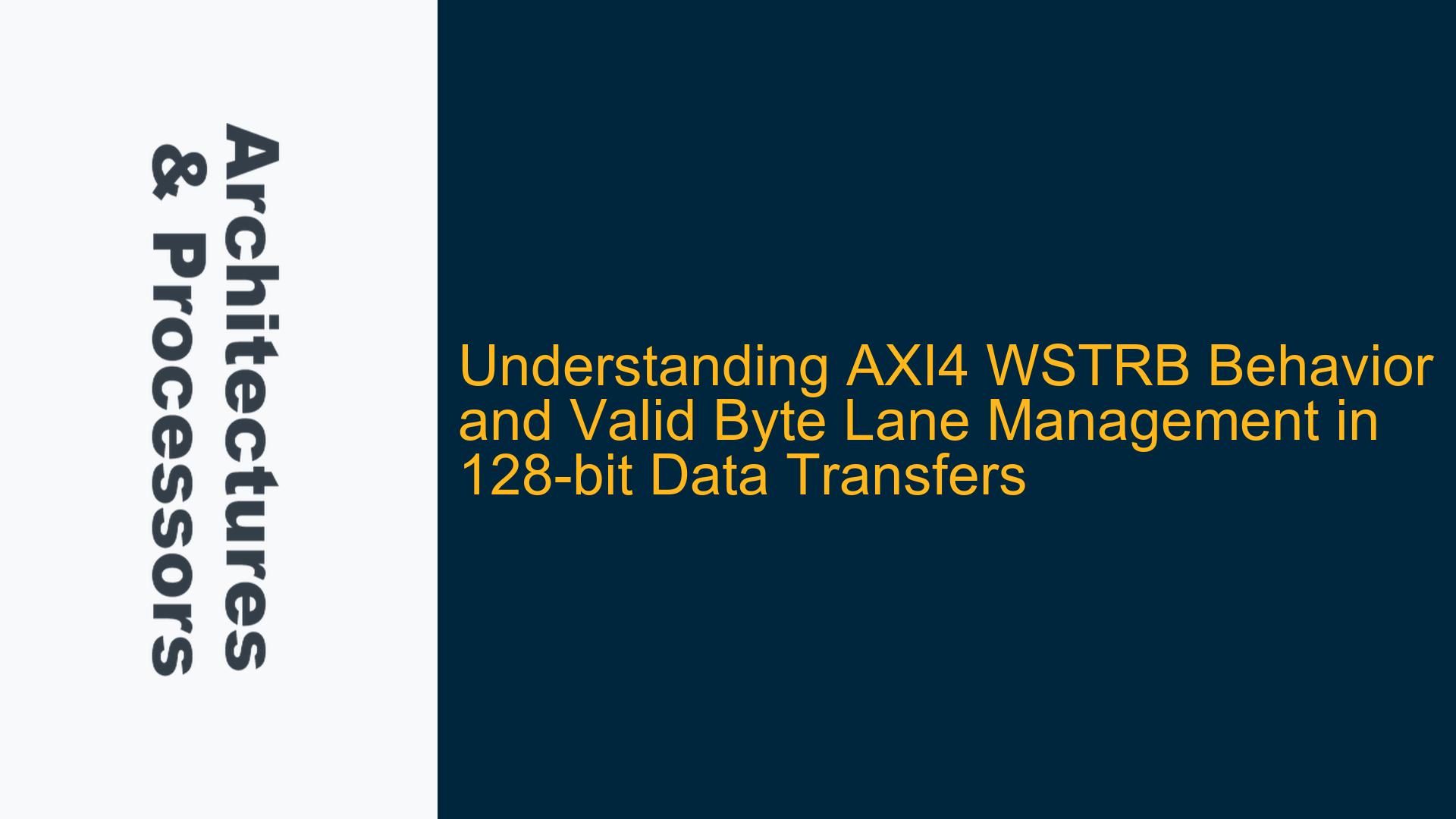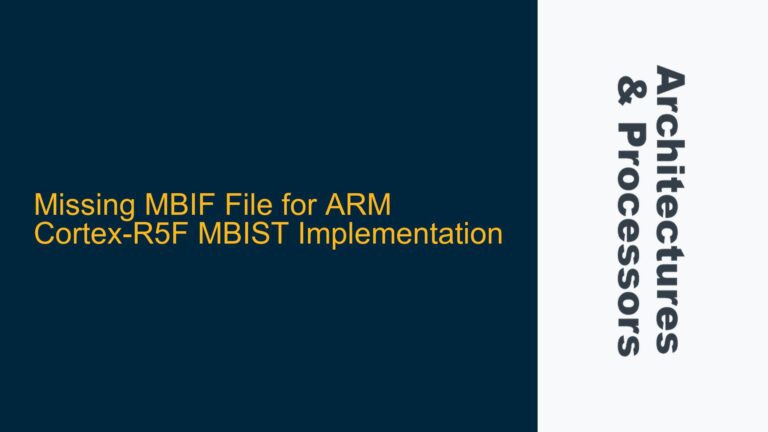AXI4 WSTRB Signal Interpretation and Use Case Analysis
The AXI4 protocol defines the WSTRB signal as a critical component for managing valid byte lanes during write transactions. The WSTRB signal is a bitmask that indicates which byte lanes of the WDATA bus contain valid data. For a 128-bit WDATA bus, the WSTRB signal is 16 bits wide, with each bit corresponding to an 8-bit byte lane in the WDATA bus. Specifically, WSTRB[n] corresponds to WDATA[(8n)+7 : (8n)]. The master is responsible for ensuring that the WSTRB signal accurately reflects the valid byte lanes, and the slave must interpret this signal correctly to process the data.
In the provided use cases, the WDATA bus is 128 bits wide, and the WSTRB signal is 16 bits wide. The master initiates a single-beat fixed burst transfer with a transfer size of 16 bits. The address (AWADDR) is set to 0, indicating that the transfer starts at the first byte of the WDATA bus. The three use cases explore different WSTRB values and their implications on the data transfer.
Use Case I: WSTRB = 1 (0000_0000_0000_0001)
In this scenario, the WSTRB signal is set to 1, indicating that only the first byte lane (WDATA[7:0]) contains valid data. The master intends to write the value 0x2 to the slave. Since the WSTRB signal specifies that only the first byte lane is valid, the slave will interpret the WDATA bus as having valid data only in the first byte lane. The value 0x2 is placed in WDATA[7:0], and the remaining byte lanes are considered invalid. The slave will write the value 0x2 to the memory location corresponding to address 0x0.
Use Case II: WSTRB = 2 (0000_0000_0000_0010)
In this case, the WSTRB signal is set to 2, indicating that only the second byte lane (WDATA[15:8]) contains valid data. The master intends to write the value 0x2 to the slave. However, since the WSTRB signal specifies that only the second byte lane is valid, the master must shift the value 0x2 to the second byte lane. The value 0x2 is placed in WDATA[15:8], and the remaining byte lanes are considered invalid. The slave will write the value 0x2 to the memory location corresponding to address 0x1.
Use Case III: WSTRB = 3 (0000_0000_0000_0011)
In this scenario, the WSTRB signal is set to 3, indicating that both the first and second byte lanes (WDATA[7:0] and WDATA[15:8]) contain valid data. The master intends to write the value 0x2 to the slave. Since the WSTRB signal specifies that both byte lanes are valid, the master places the value 0x2 in both WDATA[7:0] and WDATA[15:8]. The slave will write the value 0x2 to the memory locations corresponding to addresses 0x0 and 0x1.
Potential Misinterpretations and Common Pitfalls in WSTRB Handling
The correct interpretation of the WSTRB signal is crucial for ensuring accurate data transfer between the master and the slave. Misinterpretation of the WSTRB signal can lead to incorrect data being written to the slave, which can cause functional errors in the system. Below are some potential misinterpretations and common pitfalls that can occur when handling the WSTRB signal.
Misinterpretation of WSTRB as a Data Shift Indicator
One common mistake is interpreting the WSTRB signal as an indicator for shifting data within the WDATA bus. The WSTRB signal does not dictate how the data should be shifted; it only indicates which byte lanes contain valid data. The master is responsible for placing the data in the correct byte lanes based on the WSTRB signal. For example, in Use Case II, the master must shift the value 0x2 to the second byte lane (WDATA[15:8]) because the WSTRB signal indicates that only the second byte lane is valid. Misinterpreting the WSTRB signal as a shift indicator can lead to incorrect data placement and subsequent errors in the slave.
Incorrect WSTRB Signal Generation
Another common pitfall is the incorrect generation of the WSTRB signal by the master. The master must ensure that the WSTRB signal accurately reflects the valid byte lanes in the WDATA bus. If the WSTRB signal is incorrectly generated, the slave may misinterpret the valid byte lanes, leading to incorrect data being written. For example, if the master intends to write data to multiple byte lanes but generates a WSTRB signal that only indicates a single byte lane as valid, the slave will only write data to the specified byte lane, leaving the other byte lanes unchanged.
Slave-Side WSTRB Signal Handling
The slave must correctly interpret the WSTRB signal to ensure that only the valid byte lanes are processed. If the slave incorrectly interprets the WSTRB signal, it may process invalid byte lanes, leading to data corruption. For example, if the WSTRB signal indicates that only the first byte lane is valid, but the slave processes all byte lanes, it may overwrite valid data in the other byte lanes with invalid data.
Synchronization Issues Between Master and Slave
Synchronization issues between the master and the slave can also lead to incorrect handling of the WSTRB signal. If the master and the slave are not properly synchronized, the slave may misinterpret the WSTRB signal, leading to incorrect data being written. For example, if the master updates the WSTRB signal before the slave has finished processing the previous transaction, the slave may use the updated WSTRB signal for the previous transaction, leading to incorrect data being written.
Best Practices for WSTRB Signal Management and Verification
To ensure accurate data transfer and avoid the pitfalls discussed above, it is essential to follow best practices for WSTRB signal management and verification. Below are some recommended practices for handling the WSTRB signal in AXI4-based designs.
Master-Side WSTRB Signal Generation
The master must ensure that the WSTRB signal accurately reflects the valid byte lanes in the WDATA bus. The master should generate the WSTRB signal based on the transfer size, address, and data alignment. For example, if the transfer size is 16 bits and the address is aligned to a 16-bit boundary, the master should generate a WSTRB signal that indicates both byte lanes as valid. If the transfer size is 8 bits, the master should generate a WSTRB signal that indicates only the relevant byte lane as valid.
Slave-Side WSTRB Signal Interpretation
The slave must correctly interpret the WSTRB signal to ensure that only the valid byte lanes are processed. The slave should use the WSTRB signal to mask the invalid byte lanes in the WDATA bus before writing the data to memory. For example, if the WSTRB signal indicates that only the first byte lane is valid, the slave should only write the data in the first byte lane to memory, leaving the other byte lanes unchanged.
Verification of WSTRB Signal Handling
Verification of WSTRB signal handling is crucial to ensure that both the master and the slave correctly interpret and process the WSTRB signal. The verification process should include the following steps:
-
Functional Verification: Verify that the master correctly generates the WSTRB signal based on the transfer size, address, and data alignment. This can be done using simulation environments such as SystemVerilog and UVM. The testbench should include test cases that cover all possible combinations of transfer sizes, addresses, and data alignments.
-
Corner Case Verification: Verify that the master and the slave correctly handle corner cases, such as unaligned addresses, partial transfers, and edge cases of the WSTRB signal. For example, verify that the master correctly generates the WSTRB signal for a transfer that starts at an unaligned address and spans multiple byte lanes.
-
Synchronization Verification: Verify that the master and the slave are properly synchronized and that the slave correctly interprets the WSTRB signal for each transaction. This can be done by adding synchronization checks in the testbench to ensure that the slave processes the WSTRB signal only after the master has completed the transaction.
-
Error Injection: Inject errors into the WSTRB signal to verify that the slave correctly handles invalid WSTRB signals. For example, inject a WSTRB signal that indicates more byte lanes as valid than the transfer size allows and verify that the slave correctly masks the invalid byte lanes.
Debugging WSTRB Signal Issues
When debugging WSTRB signal issues, it is essential to systematically analyze the master and slave behavior. The following steps can help identify and resolve WSTRB signal issues:
-
Log WSTRB Signal and WDATA Bus: Log the WSTRB signal and WDATA bus for each transaction to verify that the master is generating the correct WSTRB signal and that the slave is correctly interpreting it. This can be done using simulation tools that support transaction logging.
-
Check Address Alignment: Verify that the address is correctly aligned with the transfer size and that the master is generating the correct WSTRB signal based on the address alignment. Misaligned addresses can lead to incorrect WSTRB signal generation.
-
Verify Data Placement: Verify that the master is placing the data in the correct byte lanes based on the WSTRB signal. For example, if the WSTRB signal indicates that only the second byte lane is valid, verify that the master has placed the data in the second byte lane.
-
Check Slave-Side Masking: Verify that the slave is correctly masking the invalid byte lanes based on the WSTRB signal. This can be done by checking the memory contents after each transaction to ensure that only the valid byte lanes have been updated.
-
Analyze Synchronization: Verify that the master and the slave are properly synchronized and that the slave is processing the WSTRB signal only after the master has completed the transaction. This can be done by adding synchronization checks in the testbench.
Conclusion
The WSTRB signal is a critical component of the AXI4 protocol that ensures accurate data transfer between the master and the slave. Proper handling of the WSTRB signal is essential to avoid data corruption and functional errors in the system. By following the best practices outlined above, designers can ensure that the WSTRB signal is correctly generated, interpreted, and verified, leading to robust and reliable AXI4-based designs.






